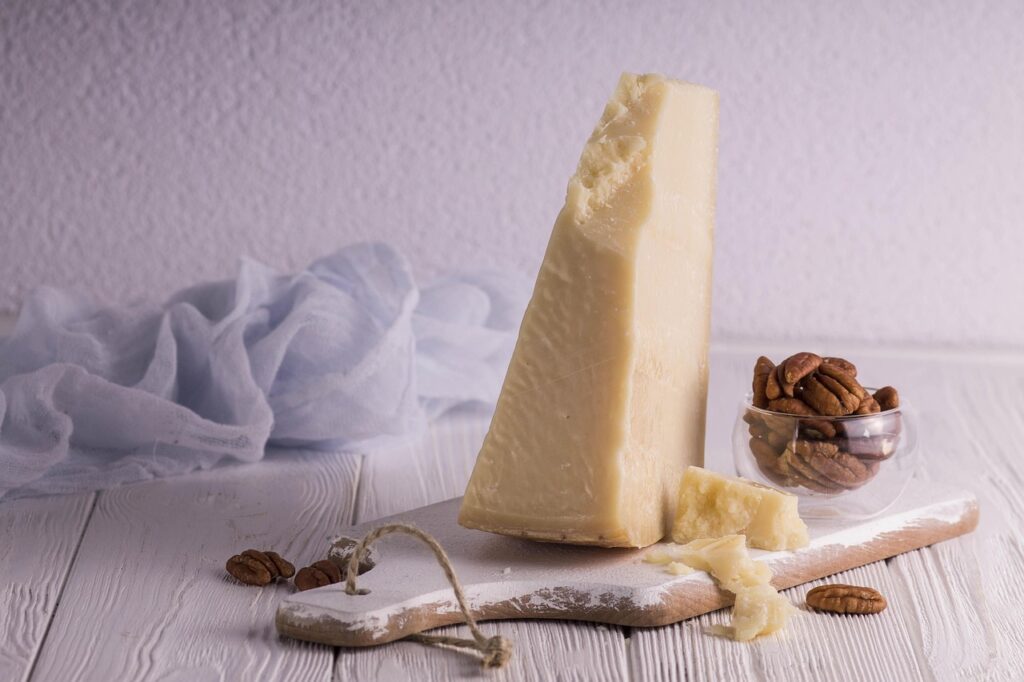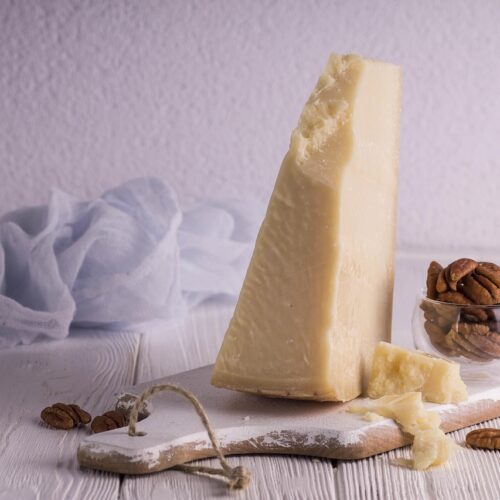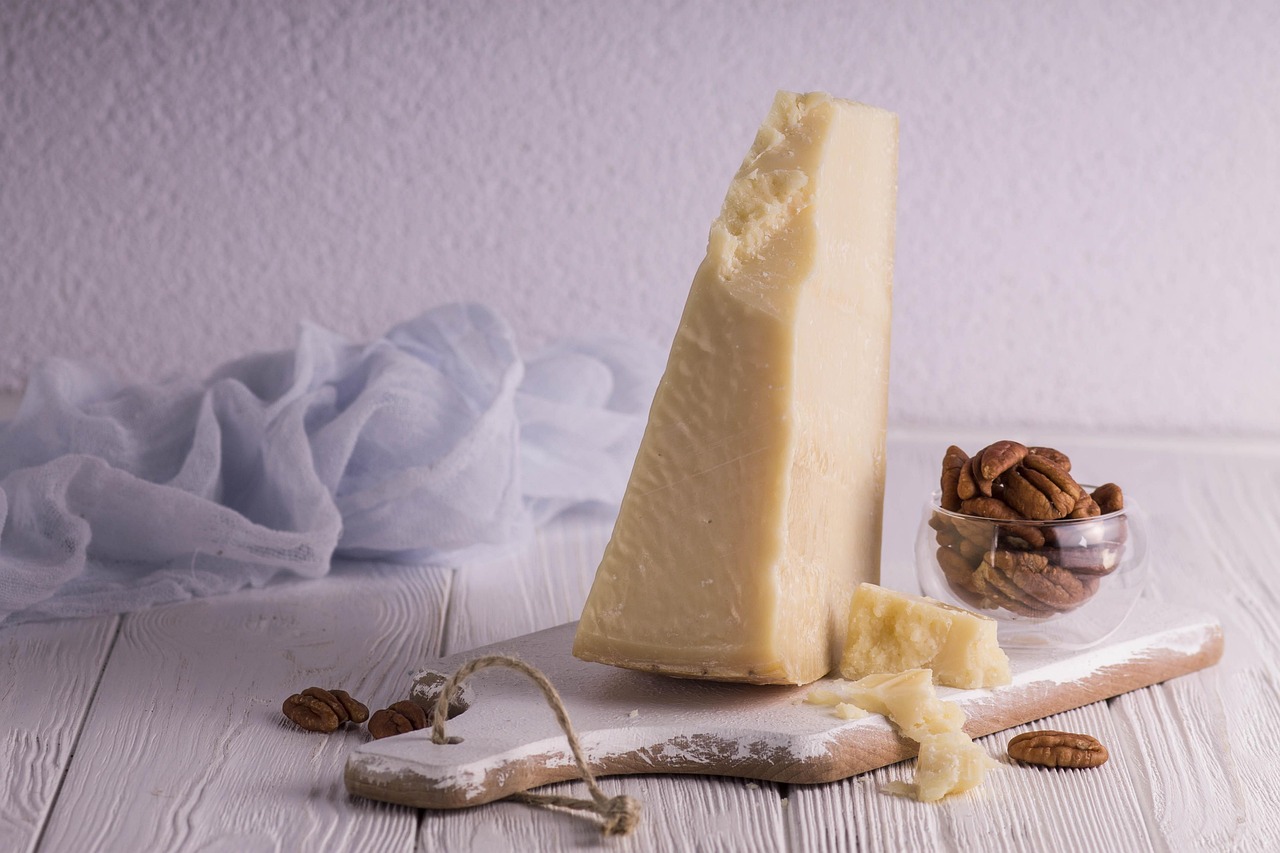The name “Parmesan” is commonly used outside of Europe to refer to Parmigiano-Reggiano, a traditional Italian cheese with Protected Designation of Origin (PDO) status.

Ratings 05

What Is Parmesan?
01. Key Facts About Parmesan
- Origin: Italy (mainly Parma, Reggio Emilia, Modena, and parts of Bologna and Mantua)
- Texture: Hard and granular
- Color: Pale yellow
- Flavor: Umami-rich, salty, and nutty
- Aging Time: Typically aged 12–36 months
- Uses: Grated over pasta, added to soups, shaved into salads, or eaten as a snack
Health Benefits Of Parmesan
Parmesan cheese (especially authentic Parmigiano-Reggiano) is not only flavorful but also offers several nutritional benefits when consumed in moderation:
01. Rich In Calcium
Parmesan is an excellent source of calcium, which is essential for strong bones and teeth, and may help prevent osteoporosis.
02. High In Protein
It contains all nine essential amino acids, making it a complete protein — great for muscle repair and growth.
03. Easily Digestible
Aged Parmesan is low in lactose due to the fermentation process, making it easier to digest for lactose-intolerant individuals.
04. Supports Nervous System
Rich in vitamins B12 and B2 (riboflavin), Parmesan supports nerve function and energy metabolism.
05. Contains Phosphorus & Zinc
These minerals are important for immune function, cell growth, and bone health.
06. Low In Carbs
Due to the extremely low carbohydrate content, parmesan is appropriate for ketosis or low-carb diets.
07. Note
- It is best consumed in moderation; it is high in sodium and fat.
- Portion control is key to balancing its nutritional benefits.
Tips For Making Parmesan
Tips For Making & Using Parmesan Cheese
While traditional Parmesan (Parmigiano-Reggiano) is typically made by certified producers in Italy, here are tips both for using Parmesan in cooking and for those interested in making a Parmesan-style cheese at home:
01. Tips For Using Parmesan In Cooking
1. Use Freshly Grated Parmesan
Always grate Parmesan fresh for the best flavor and texture—pre-shredded versions often contain anti-caking agents.
02. Add At The End Of Cooking
Parmesan melts quickly. To avoid a grainy texture, add it at the end of cooking or as a topping.
03. Use Parmesan Rinds In Soups
Save the hard rinds and simmer them in soups, stews, or sauces to add deep umami flavor.
04. Pair With Simple Ingredients
Its strong flavor complements dishes like pasta, risotto, salads, and roasted vegetables.
05. Balance The Saltiness
Parmesan is naturally salty—adjust other salt levels in your dish accordingly.
06. Shave, Grate, Or Crisp It
Shaved Parmesan is great on salads, grated for pasta, and baked into Parmesan crisps for snacks or garnishes.
02. Tips For Making Parmesan-Style Cheese At Home (Advanced)
01. Use High-Quality Raw Cow’s Milk
For authentic taste and texture, raw, unpasteurized milk is the best.
02. Maintain Proper Aging Conditions
Parmesan must age for 12–24 months in a temperature- and humidity-controlled environment.
03. Use The Right Cultures & Rennet
Thermophilic bacterial cultures and animal rennet are traditional.
04. Turn And Brush The Cheese Regularly
Turning and brushing assistance in rind advancement and spoilage protection as the merchandise ages
05. Patience Is Essential
True Parmesan develops flavor over time—the longer it ages, the deeper and nuttier it becomes.
FAQ Parmesan
Here are some frequently asked questions about Parmesan cheese:
01. Is Parmesan The Same As Parmigiano-Reggiano?
No, not exactly.
Parmigiano-Reggiano is a specific type of Parmesan produced under strict guidelines in specific Italian regions. The term “Parmesan” is often used generically outside Europe, but only cheese made in designated areas can legally be called Parmigiano-Reggiano.
02. Is Parmesan vegetarian?
Traditional Parmesan is not vegetarian.
It typically uses animal rennet in production. However, vegetarian-friendly Parmesan-style cheeses are available and use microbial or plant-based rennet.
03. Does Parmesan Cheese Need To Be Refrigerated?
Yes.
Once opened, store it in the refrigerator wrapped in wax paper or foil to keep it from drying out. Unopened vacuum-sealed Parmesan can be kept at room temperature for short periods, but refrigeration is safest.
04. How Long Does Parmesan Last?
- Unopened: Several months past the “best by” date if refrigerated
- Opened: Up to 4–6 weeks in the fridge
- Grated Parmesan: Shorter shelf life; check for mold or off smell
05. Can Parmesan Be Frozen?
Yes, but with caution.
Freezing Parmesan may affect its texture, making it more crumbly. It’s best to freeze grated Parmesan for use in cooked dishes.
06. Is Parmesan Cheese Lactose-Free?
Almost.
Aged Parmesan contains very low lactose, making it generally safe for most lactose-intolerant individuals.
07. What Are Parmesan Rinds Used For?
Don’t throw them away!
Add them to soups, sauces, or stews for extra umami flavor. Just remove before serving.

Parmesan
Ingredients
- 1 cup freshly grated Parmesan cheese
- Optional: ground black pepper, garlic powder, or Italian herbs for added flavor
Instructions
- Preheat oven to 400°F (200°C).
- Line a baking sheet with parchment paper or a silicone baking mat.
- Spoon tablespoons of grated Parmesan onto the sheet, spacing them about 2 inches apart.
- Flatten each mound slightly with the back of the spoon.
- (Optional) Sprinkle with pepper, garlic powder, or herbs.
- Bake for 5–7 minutes, or until the edges are golden and crispy.
- Cool completely before serving. They will firm up as they cool.
-
Parmesan
The name “Parmesan” is commonly used outside of Europe to refer to Parmigiano-Reggiano, a traditional Italian cheese with Protected Designation of Origin (PDO) status. Ratings 05 What Is Parmesan? 01. Key Facts About Parmesan Health Benefits Of Parmesan Parmesan cheese (especially authentic Parmigiano-Reggiano) is not only flavorful but also offers several nutritional benefits when consumed…


Leave a Comment